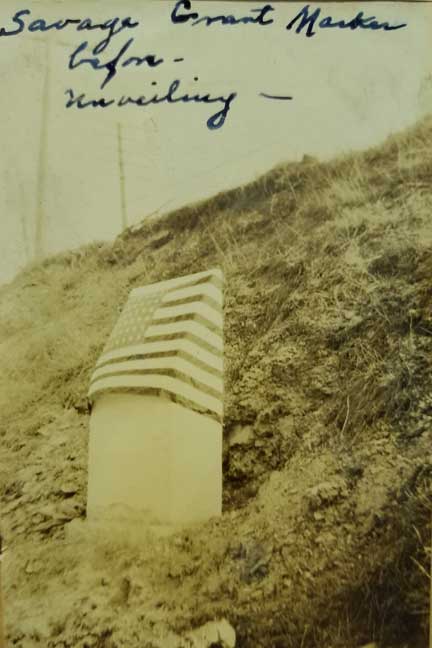Savage Land Grant & Marker
 In an effort to recruit soldiers for the Virginia Regiment of the British Army, Governor Dinwiddie of Virginia in 1754 proposed that wilderness land be offered to any man who would serve in the army. George Washington was Colonel of the Virginia Regiment at this time. One of the soldiers under Washington was Captain John Savage. In 1772 following the battle of Great Meadows and the war’s end, Governor Dinwiddie, on behalf of King George III, made a grant of 27,600 acres to John Savage and 59 other soldiers. The transaction became known as the Savage Land Grant.
In an effort to recruit soldiers for the Virginia Regiment of the British Army, Governor Dinwiddie of Virginia in 1754 proposed that wilderness land be offered to any man who would serve in the army. George Washington was Colonel of the Virginia Regiment at this time. One of the soldiers under Washington was Captain John Savage. In 1772 following the battle of Great Meadows and the war’s end, Governor Dinwiddie, on behalf of King George III, made a grant of 27,600 acres to John Savage and 59 other soldiers. The transaction became known as the Savage Land Grant.
The boundary of this land was along the Ohio River on what is now West Virginia from the mouth of Catletts Creek, past the mouth of the Big Sandy River to a point above Greenbottom and up both sides of the Big Sandy River to Fort Gay West Virginia and Louis, Kentucky. This strip of land did not go beyond the ridge tops and in most places was not more than two miles wide.
John Savage never settled on his portion of this land nor did most of the other grantees. Some sold their rights and others lost their rights because they did not make the required improvements to the land. In 1775 the land was valued at 49 cents an acre.
In 1776 after differences grew among the grantees, a suit was brought in the Superior Court at Staunton, Virginia asking that the earlier division be voided. The Court appointed five men to act as a commission to divide the Savage Grant into equal parts. The result was that the land was divided into 60 individual 460 acre lots. Today the Savage Land Grant in West Virginia is known as Ceredo, Kenova, Westmoreland, Huntington and Guyandotte.
The Cabell County Committee National Society of the Colonial Dames of America resident in the State of West Virginia placed a granite marker on the Midland Trail just above Barboursville in 1932. For the first and only time the annual WV Society meeting was held in Huntington instead of Charleston October 29, 1932. Following the meeting and luncheon, the Dames drove to the marker, and it was unveiled by Mrs. Samuel Green Biggs and Mrs. Charles W. Watts and presented to the West Virginia Society. It marks the east end of the Savage Land Grant.
